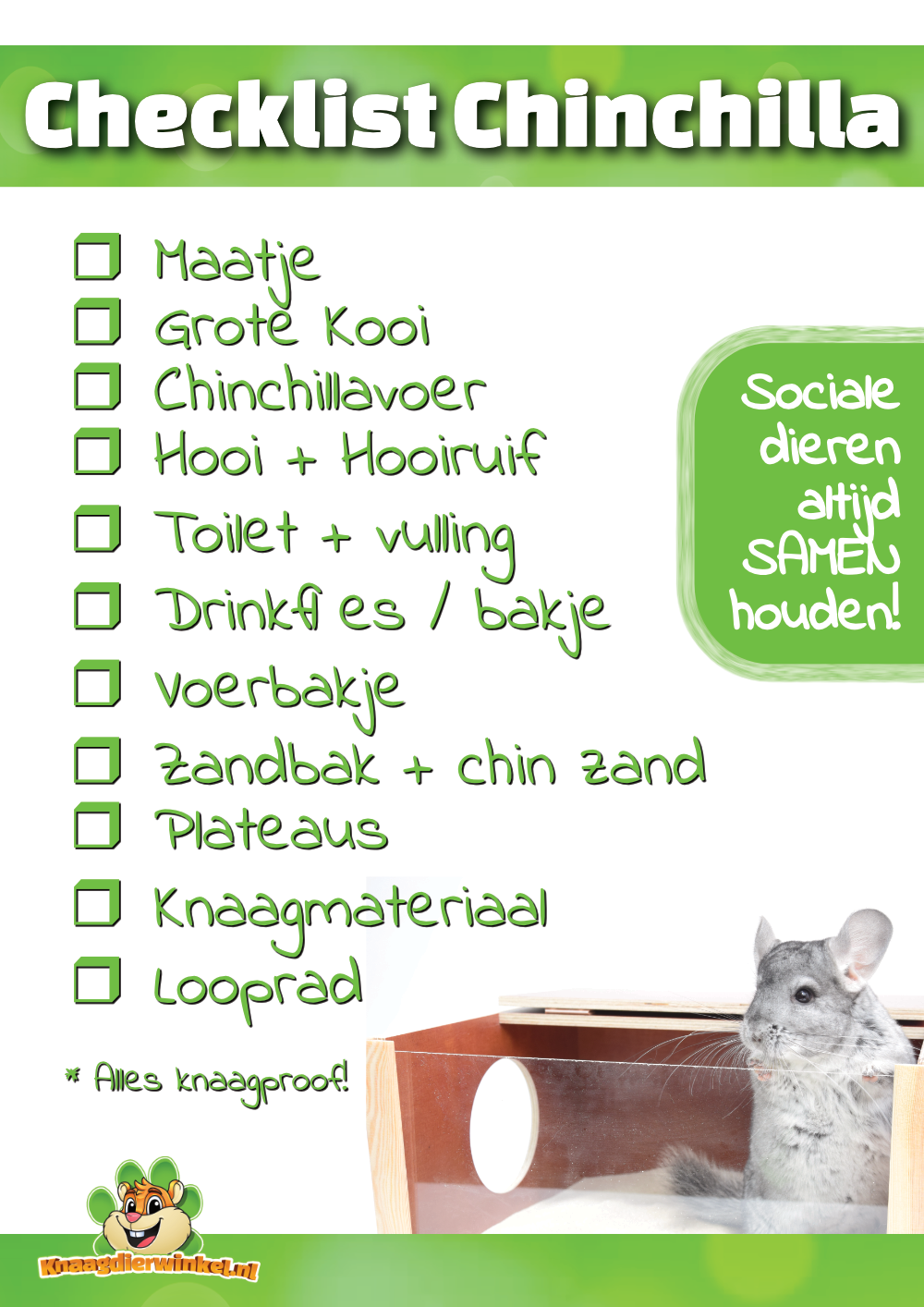The Chinchilla
 Chinchillas (Chinchilla lanigera) are cute, gentle animals that need attention. They belong to the guinea pig-like rodents and come from the Andes mountains in South America. They are active in the evening and twilight and they prefer to sleep during the day. Chinchillas (Chinchilla lanigera) are cute, gentle animals that need attention. They belong to the guinea pig-like rodents and come from the Andes mountains in South America. They are active in the evening and twilight and they prefer to sleep during the day.
Their soft, thick coat with a hair follicle from which more than 50 hairs grow makes them look like teddy bears, but nothing could be further from the truth. Although Chinchillas look cuddly, most Chins are not. They make great pets, but they are sensitive animals, so they must be handled with care and housed properly. To keep them happy and healthy, they need a special diet that is tailored to the nutritional needs of the Chinchilla. The animals also need plenty of freedom to run and jump.
- Systematics: Chinchilla lanigera, Family Chinchillidae, Order Rodentia
- Head-body length: up to 26 cm
- Body weight: 400 g to 600 g (females are slightly heavier than males)
- Life expectancy : up to 20 years
CHINCHILLA ANATOMY
Weakly muscular stomach: By ingesting several small portions per day, the food pulp is pushed to the rear of the intestines. Lifelong growth of the incisors and molars: Tooth wear occurs during eating because the teeth rub against each other. The duration of food intake is extended by eating coarse fibres, which are intensively ground. Relatively large cecum: Conversion of fine, crude cellulose by the positive intestinal flora into protein-rich and vitamin B-containing cecal pellets. These are eaten directly from the anus and undergo a second passage through the intestines.
Unlimited feeding is possible with ChinchillaDroom BASIC because it meets the energy needs of young animals during their growth process as well as the needs of adult animals.
- I . Crude fibers promote tooth wear.
- I I. Fine particles (< 0.3 mm) enter the cecum and are metabolized by the positive intestinal flora.
- I II. Particles > 0.3 mm stimulate intestinal movement. Sudden changes in feed should be avoided.
DISTRIBUTION OF THE CHINCHILLA
- native to Chile between Altamira and Talca, mainly in the coastal Cordillera area
- Currently only 2 small populations remain in north-central Chile
- seriously endangered
ChinchillaDroom BASIC contains plants from their native region, such as amaranth, maca and topinam burdock.
NATURAL HABITATS OF THE CHINCHILLA
- mainly on dry, sparsely vegetated northern slopes with loose vegetation of cacti, bromeliads and a few smaller shrubs
- mainly on fields full of crushed stone
- holes in rock crevices
CHINCHILLA BEHAVIOR
- mainly active during twilight and at night
- social, according to family ties
- possibly with territorial behavior
Chinchillas should be kept by adults as they do not like to be held or petted and are active at both dusk and night.
CHINCHILLA REPRODUCTION
- Sexually mature : females after 4-6 months, males after 4-6 months
- Breeding ready : females after 9-12 months, males after 9-10 months
- Litter size : 1-6 (Ø 2) litters per litter
- Gestation period : 105-118 (Ø 110) days
- Birth weight : 50-70 g,
- Weaning period: fledglings from week 8 -10
To avoid uncontrolled reproduction, we recommend castrating the boar. Early castration makes it possible to keep a pair from the beginning. Young animals show social behavior more easily than adults.
The cycle length is 4-5 weeks. At the end of the cycle, the females are fertile for a maximum of 48 hours.
Sex differences: In males, the distance between the genital opening and the anus is greater than in females.
CHINCHILLA FOOD
foli-herbivore: Variety of green plants supplemented with roots and vegetables. Provide sufficient good quality hay daily as well as fresh drinking water. Provide branches to nibble on.
Balanced long-life recipe: ChinchillaDroom BASIC - supplemented with Juniors Extra Chinchilla & Degoe during the growth phase - covers the nutritional needs of chinchillas.
Hay from nature protected meadows and FreshGras Hay are characterized by a multitude of green plants and herbs (biodiversity). The long, crispy stems ensure optimum tooth wear.
Good composition of Chinchilla food
- Crude protein (Rp): 13-15 %
- Crude fat (RVe): 2-4 %
- Crude fiber (CRF): 18-21%
- Crude fiber-starch ratio: at least 3:1
An optimal crude fibre-starch ratio meets the energy needs of adult animals. This protects the animal from becoming overweight.
- Calcium (Ca): Adult animals: 0.6-0.8% Young animals: 0.9 - 1.0% for bone formation during the growth phase
- Phosphorus (F): 0.4-0.7% (Ca-F ratio: 1.5-2:1)
Monocomponent feed (TriMello®) contains the necessary nutrients. Vegetables and blossoms make the feed intake more varied. Apple wood stimulates gnawing. The sensitive caecal fl ora can gradually adapt thanks to a step-by-step change in feed.
Excess calcium is mainly excreted via the intestines. Chinchillas are therefore less susceptible to bladder grit/stones.
HANDLING THE CHINCHILLA
- During the first few days, chinchillas need a lot of rest to get used to things.
- Chinchillas are mainly active in the early morning and evening and do not like to be petted, so it is best for children to just watch them.
- Lift the animals with one hand around the shoulder and chest and support their hind legs with the other hand.
- Never pick up chinchillas by their sensitive tail.
- bunnyINTERACTIVE stimulates chinchillas both mentally and physically, intensifies the bond between owner and animal and improves trust.
The Enjoy Nature range offers a variety of natural products that are suitable for building a bond of trust during the acclimatisation period and as a stimulus for play and exploration behaviour.
Check the animal's health daily, regularly the incisors, the anogenital area and the coat. A check of the weight should be done once a week.
INDICATIONS OF DISEASE
Weight loss, reduced food and water intake, changes in defecation and urination behavior, and a rough coat are some of the indications of illness.
To determine the cause and treatment, a veterinarian should be consulted as soon as possible. If the tooth wear in the chinchilla is not progressing properly, treatments under anesthesia should be performed by a veterinarian.
HOUSING THE CHINCHILLA
Chinchillas are social animals that live in family groups in the wild. In captivity they must be kept together. It is particularly beautiful to see how the animals interact, cuddle and sleep together.
For two chinchillas you will need a large cage of at least one square meter of floor space. Bigger is always better.
- don't keep alone
- at least a few
- recommended: 1 neutered male and 1 female
- In same-sex groups, animals may bite each other after reaching sexual maturity
Chinchillas should not be kept together with guinea pigs or other rodents.
CHINCHILLA CAGE PLACEMENT
- draft-free
- no direct sunlight
- relative humidity 30-50 %
- optimum ambient temperature 15 to 18° C, not permanently above 25° C
Chinchillas come from cool, dry high mountain areas. The animal does not tolerate heat and humidity well.
Chinchilla cage size
- at least a volume of 3 m3, at least 50 cm wide and 150 cm high for two animals
- for each additional adult animal at least 0.5 m3 extra must be provided
- also offer the opportunity for supervised outdoor play every day
A large structured aviary allows for intensive movement during the active phase. Free range should be allowed during active hours in the early morning or evening under supervision to encourage natural behaviour such as exploring, playing and jumping.
Ground cover for the Chinchilla
- good absorbency
- odor-binding, especially ammonia-binding
- dust-free
- soft
- replace regularly
CHINCHILLA CAGE SETUP
- 1 house per animal (min. 30 x 30 x 20 cm) with two openings
- platforms at different heights
- climbing branch
- gnawing wood eg. Back to the ROOTS
- always provide the opportunity to bathe in the sand
- feed in sturdy clay or ceramic bowls (clean the bowls daily)
- drinking water in bottles or bowls (change the water daily)
Chinchillas have a dense, fine coat. The hairs are gathered in bundles. Around a top coat there are approximately 50-75 woolly hairs. For proper coat cleaning it is important to use special chinchilla sand to avoid greasy hairs and swellings. In addition to caring for the coat, the sand bath also serves to reduce stress.
KEEPING CHINCHILLAS OUTSIDE?
- only possible during the summer months, but we do not recommend it
- provide protection from predators, rain, direct sunlight
High temperatures and humidity are poorly tolerated.
CHINCHILLA FOOD
Chinchillas are small, folivorous / herbivorous (plant-eating) mammals and belong to the order of rodents. They are mainly active at dusk and at night, very social and live in the wild in family groups as one pair and their female offspring. Even if they are kept as pets, they should not be left alone. As a pair or in a group (a castrated male and one or more females) they feel good. A chinchilla can live up to 20 years and reaches a body length of approx. 26 cm and a weight of 400 to 600 g.
Chinchillas originate from South America and live there in rocky mountain slopes near the coast. Their survival is highly threatened and today there are only 2 small remaining populations in the north of central Chile.
The vegetation in their country of origin varies and often shows a desert character. They prefer dry and sparsely vegetated slopes with a loose vegetation consisting of cacti, bromeliads and small shrubs. They make their burrows in rock crevices.
Chinchillas feed on plant foods and are able to process them optimally.
Chinchillas have very specific nutritional needs.
The digestive system is important for a healthy and vital life.
Teeth
There are two incisors in each of the upper and lower jaws, which, like the molars, continue to grow throughout life. A rough fiber structure in the diet is necessary for tooth wear.
Stomach
The stomach is only moderately muscular and therefore cannot transport the food pulp to the next section of the intestine on its own. The following food portions take over that task.
appendix
Fine dietary fibres end up in the voluminous appendix, which are converted into proteins, vitamin B complex and vitamin K by special bacteria. That is why the appendix is also called the fermentation chamber. The formed appendix pellets are reabsorbed by chinchillas.
RATIO OF CRUDE FIBER AND STARCH
Crude fibers: Crude fibers are very important for health. They support digestion, the appendix and with their rough fiber structure, tooth wear.
Starch: Starch is mainly an energy supplier and should be present in limited quantities in the feed.
A shift in the crude fiber-starch ratio can lead to long-term health damage:
- Too little crude fibre leads to intestinal sluggishness, changes in intestinal flora and disturbed functioning of the appendix.
- Too much starch leads to eating pauses, changes in intestinal flora, swelling, diarrhea, fermentation, obesity.
That is why veterinarians recommend a minimum crude fiber to starch ratio of 3:1.
How do I actually know how much starch my food contains?
The composition is very useful: whole grains (with starchy endosperm), field beans, potatoes or peas are an indication that a higher starch content should be taken into account.
|



